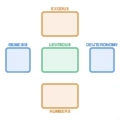Torah Weave Research Articles
Explore our collection of academic articles examining the sophisticated literary structure of the Torah. Our research reveals patterns that become visible when viewing the text as a woven tapestry with both horizontal and vertical elements.
Three-Part Series on the Decalogue (Ten Commandments)
Divine Speech in Two Dimensions
This research examines how the Ten Commandments reveal a sophisticated literary structure organized as five consecutive pairs across two tablets. By analyzing the biblical description of the stone tablets, this study uncovers evidence that the Decalogue serves as a paradigm for understanding the entire Torah's composition as a woven text with both linear and non-linear dimensions. The article demonstrates how this tabular structure reflects a fundamental distinction between divine and human modes of communication.
Read the full article →The Five Pairs of Avot 1: Reading Between the Lines
This research examines how the ten aphorisms of the Five Pairs in Tractate Avot reveal a sophisticated literary structure organized as a tabular composition. By analyzing the Maharal of Prague's insights and applying modern literary analysis, this study demonstrates how progressive literary devices transform readers from passive recipients to active creators of meaning. The article shows how this five-stage structure models the very process of esoteric transmission it describes, suggesting continuity with the paired structure of the Decalogue.
Read the full article →Bidirectional Reading: The Decalogue and Avot Pairs as Literary Tables
This article brings together our previous analyses to demonstrate how Rabbi Judah ha-Nasi's arrangement of the Avot pairs deliberately mirrors the five-pair structure of the Decalogue. By examining the inverse hierarchical organization of these texts, we reveal how both employ identical literary techniques to create bidirectional readings that transform the reader from passive recipient to active participant in revelation. The research shows how the Decalogue's structure was preserved as esoteric knowledge through Rabbi's parallel composition in Tractate Avot.
Read the full article →Three-Part Series on Leviticus Chapter 19 (Unit 13)
The Sophisticated Literary Structure of Leviticus 19 (Part 1)
For millennia, Leviticus Unit 13 appeared to be a random compilation of laws. In Part 1, we uncover its hidden design by analyzing textual markers like divine formulas and opening phrases. The unit divides into two parallel columns—one focusing on relationship with the deity, the other on social responsibilities. Each column contains its own internal progression, with the left column moving from unity to separation and the right column moving from separation to unity. This discovery transforms our understanding from a miscellaneous collection to an intentionally crafted composition.
Read the full article →The Sophisticated Literary Structure of Leviticus 19 (Part 2)
Building on Part 1's discovery of two parallel columns, Part 2 reveals that Leviticus Unit 13 organizes into five consecutive pairs, each with a unique structure. These pairs create a systematic progression from inseparable unity to complete separation. Additionally, references to the deity follow the same pattern—from essential to disconnected—creating a "divine process" that mirrors the structural progression. This tabular structure transforms our understanding of the text, explaining puzzling repetitions and revealing connections that remain hidden when reading the text linearly.
Read the full article →The Sophisticated Literary Structure of Leviticus 19 (Part 3)
Part 3 completes our analysis by linking Leviticus Unit 13 to the structure of the Ten Commandments. We demonstrate that both texts share the same five-pair arrangement, with Unit 13 systematically incorporating elements of the Decalogue in a progressively deviating pattern. We also examine the central bridging section (vv. 19b-25) that connects the two columns through three parallel processes, and explore Unit 13's position within the entire Torah structure—serving as the literary equivalent of the Ark of the Covenant at the center of the Tabernacle and positioned at the intersection of the Torah's horizontal and vertical dimensions.
Read the full article →